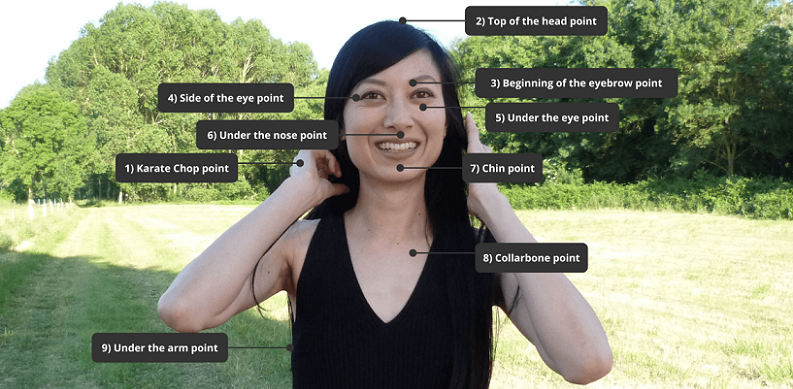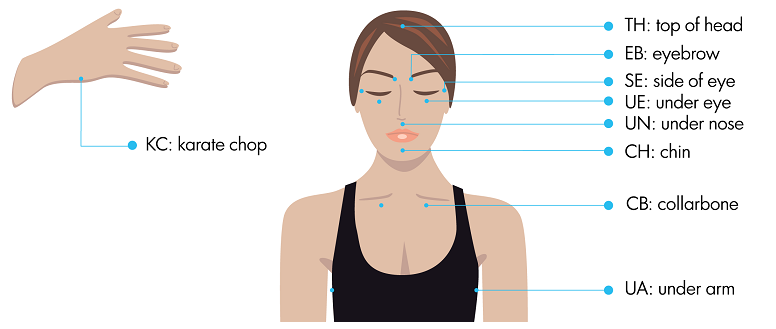
Emotional Freedom Technique, or EFT, is a powerful practice that can help you tap your way to wellness. EFT, sometimes referred to as “tapping,” is a mind-body healing approach that combines elements of ancient Chinese medicine with modern psychology. Here we examine the science behind EFT, walk you through the basic tapping sequence, discuss its practical applications for various issues, and offer tips to maximize its benefits.
Contents
Introduction to Emotional Freedom Technique (EFT)
Emotional Freedom Technique (EFT) is an innovative and powerful self-help tool that aims to address a range of emotional and physical issues by harnessing the body’s energy system.
Definition of EFT
EFT is a non-invasive, easy-to-learn technique that combines the principles of ancient Chinese medicine with modern psychology. It involves tapping on specific acupressure points on the body, also known as meridian points, while focusing on a particular issue or concern. This process is believed to help release negative emotions, alleviate physical discomfort, and promote overall well-being.
Origins and Development
EFT was first introduced in the 1990s by Gary Craig, a Stanford-trained engineer, and personal performance coach. Craig’s work was heavily influenced by Dr. Roger Callahan’s Thought Field Therapy (TFT), which is another tapping-based approach [1]. Craig sought to simplify and improve upon TFT, making it more accessible and user-friendly. Since its inception, EFT has evolved and been adapted by various practitioners, leading to the development of several different styles and variations.
Overview of Tapping Process
The EFT tapping process consists of several steps, including identifying the issue or concern, crafting a setup statement, performing the tapping sequence on meridian points, and reassessing the issue to determine if further tapping is needed. The process is designed to be easy to learn and can be practiced independently or with the guidance of an EFT practitioner. The simplicity and flexibility of EFT have contributed to its growing popularity as a tool for emotional and physical healing.

The Science Behind EFT
As we delve into the science behind Emotional Freedom Technique (EFT), it’s essential to understand the role of meridian points, the connection to acupuncture, and the impact on the amygdala. Additionally, we’ll explore the research conducted on EFT’s effectiveness to provide a comprehensive understanding of this technique’s scientific basis.
Meridian Points and Energy Flow
In traditional Chinese medicine, meridians are believed to be channels through which vital energy, or “qi,” flows throughout the body. There are 12 major meridians, each corresponding to a specific organ system, and numerous smaller meridians [2]. EFT tapping focuses on key meridian points, which are thought to be connected to emotional and physical issues. By tapping on these points, practitioners believe that blockages in energy flow can be released, allowing the body to return to a state of balance and wellness.
EFT’s Connection to Acupuncture
EFT’s foundation in Chinese medicine closely ties it to acupuncture, a millennia-old practice that involves inserting thin needles into specific points on the body to stimulate energy flow and promote healing. Both EFT and acupuncture target the same meridian points, but EFT uses gentle tapping rather than needles. This makes EFT a more accessible and non-invasive alternative for those who might be hesitant about traditional acupuncture.
The Role of the Amygdala
The amygdala, a small almond-shaped structure in the brain, plays a crucial role in processing and storing emotional memories. It is particularly involved in the formation of fear and anxiety-related memories. EFT proponents suggest that tapping on meridian points can help stimulate the amygdala, allowing individuals to release and process negative emotions more effectively. This, in turn, is believed to reduce the intensity of emotional reactions and alleviate physical manifestations of stress [3].
Research on EFT’s Effectiveness
Over the past few decades, numerous studies have been conducted to evaluate the effectiveness of EFT in addressing various emotional and physical concerns. While some research has shown promising results, such as reduced anxiety, depression, and PTSD symptoms, the overall quality and rigor of these studies have been criticized.
More well-designed, large-scale, and peer-reviewed research is needed to fully establish EFT’s efficacy and understand its underlying mechanisms. Despite these limitations, anecdotal reports and preliminary research suggest that EFT may offer significant benefits for many individuals seeking emotional and physical relief.

Understanding the Basic EFT Tapping Sequence
Learning the EFT tapping sequence is simple and straightforward. In this section, we’ll guide you through the four main steps of the process: identifying your issue or concern, crafting a setup statement, performing the tapping sequence, and reassessing and repeating as needed. By following these steps, you’ll be well on your way to tapping your way to wellness.
Identifying Your Issue or Concern
The first step in practicing EFT is to clearly identify the issue or concern you’d like to address. This can be anything from a physical ailment, such as pain or discomfort, to an emotional issue like anxiety or fear. It’s essential to be specific and honest with yourself about the problem to help focus your tapping effectively.
Crafting a Setup Statement
Once you’ve identified your issue, you’ll need to create a setup statement that acknowledges the problem while also affirming self-acceptance. A typical setup statement follows this format: “Even though I have [issue], I deeply and completely accept myself.” For example, if you’re dealing with anxiety, your setup statement might be, “Even though I feel anxious, I deeply and completely accept myself.” This statement will be repeated while tapping on the side of the hand, also known as the karate chop point, to begin the sequence.
Performing the Tapping Sequence
After reciting your setup statement, you’ll move on to the actual tapping sequence. This involves tapping on a series of meridian points while repeating a reminder phrase related to your issue. The reminder phrase is typically a shortened version of your setup statement, such as “this anxiety.” The basic tapping points, in order, are:
- Eyebrow (EB): just above and to the side of the nose
- Side of the eye (SE): on the bone bordering the outside corner of the eye
- Under the eye (UE): on the bone below the eye
- Under the nose (UN): between the nose and the upper lip
- Chin (CH): in the crease between the lower lip and the chin
- Collarbone (CB): where the collarbone meets the breastbone
- Under the arm (UA): about 4 inches below the armpit
- Top of the head (TH): center of the crown of the head
Tap each point gently but firmly 5-7 times while repeating your reminder phrase. Complete one full round of tapping, then take a deep breath and assess how you feel.
Reassessing and Repeating as Needed
After completing one round of tapping, take a moment to reassess your emotions or physical sensations related to the issue. If you still feel significant distress, you can continue with additional tapping rounds, adjusting your setup statement and reminder phrase as needed to reflect any changes in your feelings or intensity. Continue tapping until you notice a decrease in the intensity of your issue or feel a sense of relief.

Practical Applications of EFT
Emotional Freedom Technique (EFT) is a versatile healing tool that can be applied to various issues and concerns [4]. In this section, we’ll discuss some common practical applications of EFT, including reducing stress and anxiety, overcoming fears and phobias, enhancing personal performance, promoting physical healing and pain relief, and addressing emotional trauma.
Reducing Stress and Anxiety
Stress and anxiety are common issues that many people face in today’s fast-paced world. EFT can help release stress and calm the nervous system by tapping on meridian points associated with the body’s stress response. By focusing on specific stressors and using tailored setup statements, EFT can provide a powerful means of relaxation and stress reduction.
Overcoming Fears and Phobias
Fears and phobias can significantly impact an individual’s quality of life. EFT is believed to help address these issues by targeting the amygdala, which is responsible for processing fear and anxiety-related memories. By tapping on specific points while focusing on the fear or phobia, EFT may help to rewire the brain’s response and reduce the intensity of the emotional reaction.
Enhancing Personal Performance
EFT can also be used to improve personal performance in various areas, such as sports, public speaking, and creative pursuits. By targeting limiting beliefs, self-doubt, and other psychological barriers, EFT can help individuals overcome mental blocks and unlock their full potential.
Promoting Physical Healing and Pain Relief
While EFT is often used to address emotional concerns, it has also shown promise in alleviating physical discomfort and promoting healing. By tapping on meridian points associated with specific areas of pain or discomfort, EFT may help to release energy blockages and restore balance to the body’s energy system. This can lead to reduced pain and increased physical well-being.
Addressing Emotional Trauma
Emotional trauma can have long-lasting effects on an individual’s mental and emotional health. EFT has been used by many practitioners to help clients process and release the emotional charge associated with past traumatic experiences. By focusing on the emotions tied to the trauma and tapping on specific meridian points, EFT may help individuals release the emotional burden and move towards healing.
Tips for Maximizing EFT’s Benefits
To make the most of your Emotional Freedom Technique (EFT) practice, it’s essential to follow some key guidelines and strategies. In this section, we’ll share tips for establishing a regular tapping routine, being specific with your setup statement, employing visualization techniques, and seeking assistance from EFT practitioners when needed.
Establishing a Regular Tapping Routine
Consistency is crucial when it comes to reaping the benefits of EFT. Establishing a regular tapping routine can help you become more proficient in the technique and create lasting changes in your emotional and physical well-being. Dedicate a specific time each day for your EFT practice, even if it’s just a few minutes. As you become more comfortable with tapping, you may find it easier to incorporate it into your daily life, using it as needed to address stressors or challenges as they arise.
Being Specific with Your Setup Statement
The more specific and targeted your setup statement is, the more effective your EFT practice will be. Rather than focusing on vague or general issues, try to hone in on particular aspects of your concern. For example, instead of saying, “Even though I’m stressed,” try, “Even though I’m stressed about my upcoming presentation at work, I deeply and completely accept myself.” This specificity allows you to address the root cause of your issue more directly, leading to more profound and lasting results.
Employing Visualization Techniques
Adding visualization to your EFT practice can enhance its effectiveness. While tapping, try to visualize the issue you’re addressing, as well as any related emotions or physical sensations. This can help you connect more deeply with the issue and release it more effectively. For example, when tapping for pain relief, imagine the pain dissipating and being replaced by a soothing, healing energy.
Seeking Assistance from EFT Practitioners
While EFT is designed to be a self-help tool, there may be times when you need guidance or support from a trained professional. EFT practitioners can help you refine your technique, identify and address more complex issues, and provide additional insights and resources. If you’re struggling with a particularly challenging issue or are new to EFT, consider seeking the support of a certified EFT practitioner to help you maximize the technique’s benefits.
References
[1] Emotional Freedom Technique (EFT)
[2] Clinical EFT (Emotional Freedom Techniques) Improves Multiple Physiological Markers of Health
[3] Emotional freedom technique (EFT) is an alternative therapy for anxiety, post-traumatic stress disorder (PTSD)
[4] EFT Tapping: What You Need To Know





